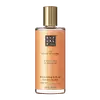What's inside
What's inside
 Key Ingredients
Key Ingredients

 Benefits
Benefits

 Concerns
Concerns

 Ingredients Side-by-side
Ingredients Side-by-side

Caprylic/Capric Triglyceride
MaskingPolyamide-8
EmollientCarthamus Tinctorius Seed Oil
MaskingOlea Europaea Fruit Oil
MaskingSimmondsia Chinensis Seed Oil
EmollientCamellia Sinensis Leaf Extract
AntimicrobialNelumbo Nucifera Flower Extract
Skin ConditioningMacrocystis Pyrifera Extract
Skin ConditioningAloe Barbadensis Leaf Extract
EmollientTocopherol
AntioxidantHelianthus Annuus Seed Oil
EmollientPentaerythrityl Tetra-Di-T-Butyl Hydroxyhydrocinnamate
AntioxidantSynthetic Fluorphlogopite
Silica
AbrasiveTin Oxide
AbrasiveSqualane
EmollientWater
Skin ConditioningGlycerin
HumectantParfum
MaskingBenzyl Salicylate
PerfumingCitral
PerfumingCitronellol
PerfumingHexyl Cinnamal
PerfumingLinalool
PerfumingAlpha-Isomethyl Ionone
PerfumingLimonene
PerfumingSodium Benzoate
MaskingPotassium Sorbate
PreservativeCitric Acid
BufferingCI 77491
Cosmetic ColorantCI 77891
Cosmetic ColorantCaprylic/Capric Triglyceride, Polyamide-8, Carthamus Tinctorius Seed Oil, Olea Europaea Fruit Oil, Simmondsia Chinensis Seed Oil, Camellia Sinensis Leaf Extract, Nelumbo Nucifera Flower Extract, Macrocystis Pyrifera Extract, Aloe Barbadensis Leaf Extract, Tocopherol, Helianthus Annuus Seed Oil, Pentaerythrityl Tetra-Di-T-Butyl Hydroxyhydrocinnamate, Synthetic Fluorphlogopite, Silica, Tin Oxide, Squalane, Water, Glycerin, Parfum, Benzyl Salicylate, Citral, Citronellol, Hexyl Cinnamal, Linalool, Alpha-Isomethyl Ionone, Limonene, Sodium Benzoate, Potassium Sorbate, Citric Acid, CI 77491, CI 77891
Glycine Soja Oil
EmollientIsopropyl Myristate
EmollientCanola Oil
EmollientCetearyl Ethylhexanoate
EmollientCarthamus Tinctorius Seed Oil
MaskingParfum
MaskingVitis Vinifera Seed Oil
EmollientMacadamia Ternifolia Seed Oil
EmollientCocos Nucifera Oil
MaskingTocopherol
AntioxidantTocopheryl Acetate
AntioxidantGardenia Taitensis Flower Extract
Skin ConditioningPrunus Amygdalus Dulcis Oil
Skin ConditioningTheobroma Cacao Seed Butter
EmollientRosa Canina Fruit Oil
EmollientArgania Spinosa Kernel Oil
EmollientDimethicone
EmollientPEG-40 Sorbitan Peroleate
EmulsifyingBenzyl Alcohol
PerfumingBenzyl Benzoate
AntimicrobialCoumarin
PerfumingGlycine Soja Oil, Isopropyl Myristate, Canola Oil, Cetearyl Ethylhexanoate, Carthamus Tinctorius Seed Oil, Parfum, Vitis Vinifera Seed Oil, Macadamia Ternifolia Seed Oil, Cocos Nucifera Oil, Tocopherol, Tocopheryl Acetate, Gardenia Taitensis Flower Extract, Prunus Amygdalus Dulcis Oil, Theobroma Cacao Seed Butter, Rosa Canina Fruit Oil, Argania Spinosa Kernel Oil, Dimethicone, PEG-40 Sorbitan Peroleate, Benzyl Alcohol, Benzyl Benzoate, Coumarin
Ingredients Explained
These ingredients are found in both products.
Ingredients higher up in an ingredient list are typically present in a larger amount.
Carthamus tinctorius seed oil comes from safflower, one of humanity's oldest crops.
Safflower seed oil contains a high percentage of linoleic acid and oleic acid. It also contains Vitamin E. These three components are effective moisturizers.
Vitamin E helps nourish your skin's lipid barrier. It is also a potent antioxidant. Antioxidants help fight free-radical molecules, or unstable molecules that may damage your skin cells.
Due to its high fatty acid content, this ingredient may not be malassezia folliculitis safe.
Thoughout history, safflower has been used for dying fabrics and in food as a saffron substitute.
Learn more about Carthamus Tinctorius Seed OilParfum is a catch-all term for an ingredient or more that is used to give a scent to products.
Also called "fragrance", this ingredient can be a blend of hundreds of chemicals or plant oils. This means every product with "fragrance" or "parfum" in the ingredients list is a different mixture.
For instance, Habanolide is a proprietary trade name for a specific aroma chemical. When used as a fragrance ingredient in cosmetics, most aroma chemicals fall under the broad labeling category of “FRAGRANCE” or “PARFUM” according to EU and US regulations.
The term 'parfum' or 'fragrance' is not regulated in many countries. In many cases, it is up to the brand to define this term.
For instance, many brands choose to label themselves as "fragrance-free" because they are not using synthetic fragrances. However, their products may still contain ingredients such as essential oils that are considered a fragrance by INCI standards.
One example is Calendula flower extract. Calendula is an essential oil that still imparts a scent or 'fragrance'.
Depending on the blend, the ingredients in the mixture can cause allergies and sensitivities on the skin. Some ingredients that are known EU allergens include linalool and citronellol.
Parfum can also be used to mask or cover an unpleasant scent.
The bottom line is: not all fragrances/parfum/ingredients are created equally. If you are worried about fragrances, we recommend taking a closer look at an ingredient. And of course, we always recommend speaking with a professional.
Learn more about ParfumTocopherol (also known as Vitamin E) is a common antioxidant used to help protect the skin from free-radicals and strengthen the skin barrier. It's also fat soluble - this means our skin is great at absorbing it.
Vitamin E also helps keep your natural skin lipids healthy. Your lipid skin barrier naturally consists of lipids, ceramides, and fatty acids. Vitamin E offers extra protection for your skin’s lipid barrier, keeping your skin healthy and nourished.
Another benefit is a bit of UV protection. Vitamin E helps reduce the damage caused by UVB rays. (It should not replace your sunscreen). Combining it with Vitamin C can decrease sunburned cells and hyperpigmentation after UV exposure.
You might have noticed Vitamin E + C often paired together. This is because it is great at stabilizing Vitamin C. Using the two together helps increase the effectiveness of both ingredients.
There are often claims that Vitamin E can reduce/prevent scarring, but these claims haven't been confirmed by scientific research.
Learn more about Tocopherol